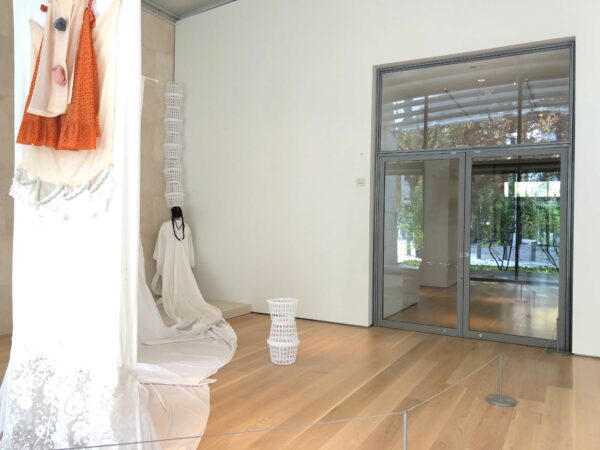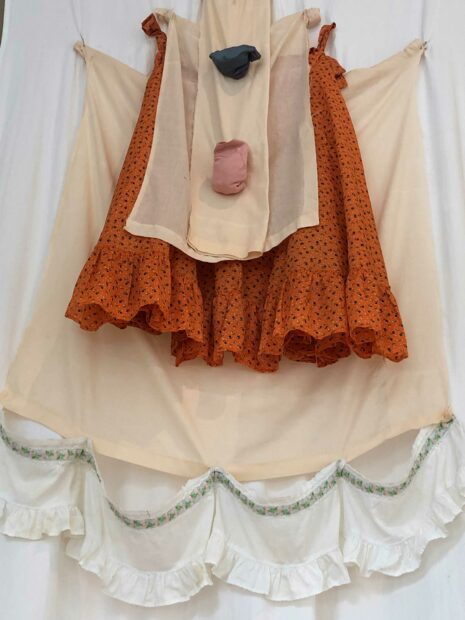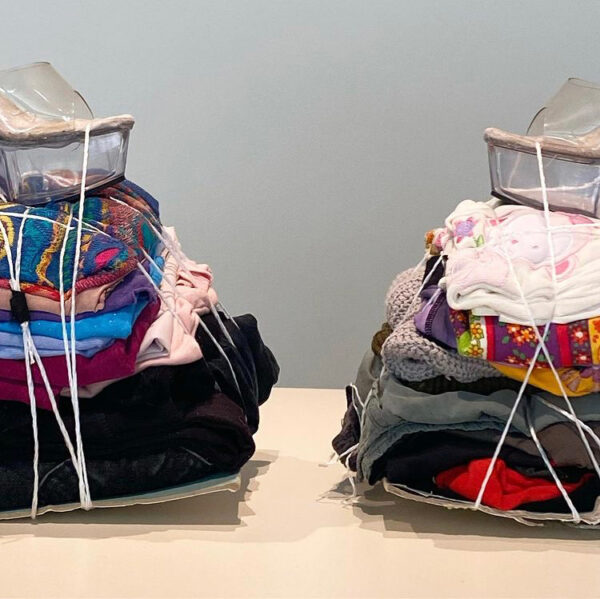In Pink Collar // Children’s Linen, Christian Cruz collapses Brancusi’s Endless Column and the myth of Sisyphus into a story of labor, elevating domestic work into the hallowed halls of the art museum.
In 2020, Cruz choreographed a series of durational performance art pieces at Dallas’ ex ovo gallery. Each was striking in its own way, but the one that stood out to me the most was Basket Performance, which consisted of a femme person standing in a corner and balancing laundry baskets that were stacked on each other in alternating order — opening to opening, and bottom to bottom. Stacked this way, the plastic containers resembled Brancusi’s most iconic sculptural form: Endless Column.
The attempt to balance the baskets was Sisyphean, possible only for a few moments before the performer had to gather them from the ground each time they toppled. Sisyphus was the Greek king doomed by Zeus to forever push a boulder up a hill as punishment, only to have it roll back down for him to push again. In Cruz’s performance, parallels to the cyclical, seemingly unending nature of domestic care work take the mundane and equate that toil to divine levels.
Through January 30, Cruz is revisiting this performance, this time enacting it with her own body, at the Nasher Sculpture Center. The museum includes multiple works by Brancusi in its permanent collection. Cruz’s performance in the museum’s gallery unfolds additional layers around its themes of “pink collar” jobs and invisible labor. Bringing abstracted references of domestic care into the Nasher’s travertine exhibition space is a way to exalt the usually under recognized work. As the artist notes, the gendered nature of this form of work is unseen by capitalism, and it depends on the unpaid labor of someone to care for the home, children, and the elderly. In a country where paid leave is limited, and daycare annually approaches the cost of college tuition, the fulfillment of these necessary tasks becomes an economic barrier to the people socialized to perform them. This reality was only compounded by the effects of 2020 and the COVID-19 pandemic.
The academic setting of the museum, with its collection that was until very recently deficient in melanated and non-men artists, imbues this work with an even broader dialogue. Cruz identifies as a queer Tejana. Balancing an unstable, hollow form of modernist sculpture on her head is akin to the balancing act that every BIPOC artist is asked to perform when navigating hierarchical spaces not built for them.
As I watched Cruz’ performance, the precarity of the task and the many levels of what the artist’s body represented became more apparent. The instability of the topmost basket, wavering with the tiniest shift in Cruz’s stance, brought to mind the metaphor of the unseen labor of farm workers — mostly indigenous-descended peoples from South America, Central America and Mexico — who ensure we have fully stocked grocery stores so we can eat. More directly (full disclosure, I used to work at the Nasher), seeing her support a multi-level hollow construct that represents modernism (and knowing that the white forms could at any moment topple, if not supported by her) mirrored the labor hierarchy of the museum complex itself. The disparity between the number of people of color employed in “housekeeping” positions and full-time white-collar jobs is drastic. The staff of the museum itself, just as in most other art non-profits, reflects this imbalance in representation,. What sets the Nasher apart is its willingness to at least engage in this dialogue by supporting local artists like Cruz through its public art grants.
The white cloth that draped Cruz seemed to emanate from the wall, subsuming her as if asking her to disappear. During a time when cleanliness is an act that prevents mass illness, the work that is necessary to make the museum’s Renzo Piano interiors habitable is always meant to go unnoticed.
Along with Cruz’s durational performance, the viewer is presented with bundles of fabric hanging from the ceiling. Beside them is a sculpture constructed from piles of laundry, tied together and topped with platform stiletto heels. Both contain clothing from Cruz’s daughter. These pieces speak to motherhood, sensuality, care, and the generative force that is necessary for humanity to exist. That these elements in 2021 are still devalued in “industrialized” nations is something Cruz seeks to correct through every breath of this living artwork.
Christian Cruz: Pink Collar // Children’s Linen is on view at the Nasher Sculpture Center through January 30, 2022. Performances are every Wednesday and Sunday during museum hours.






